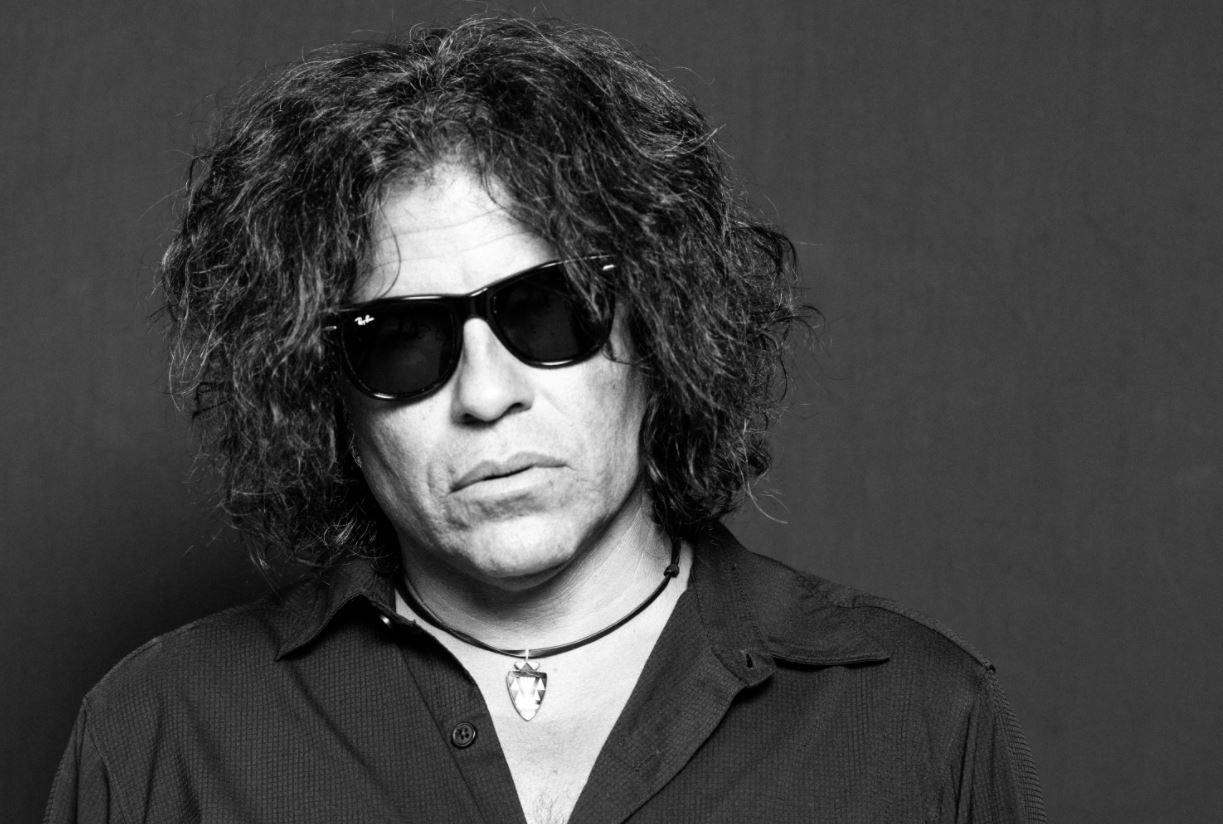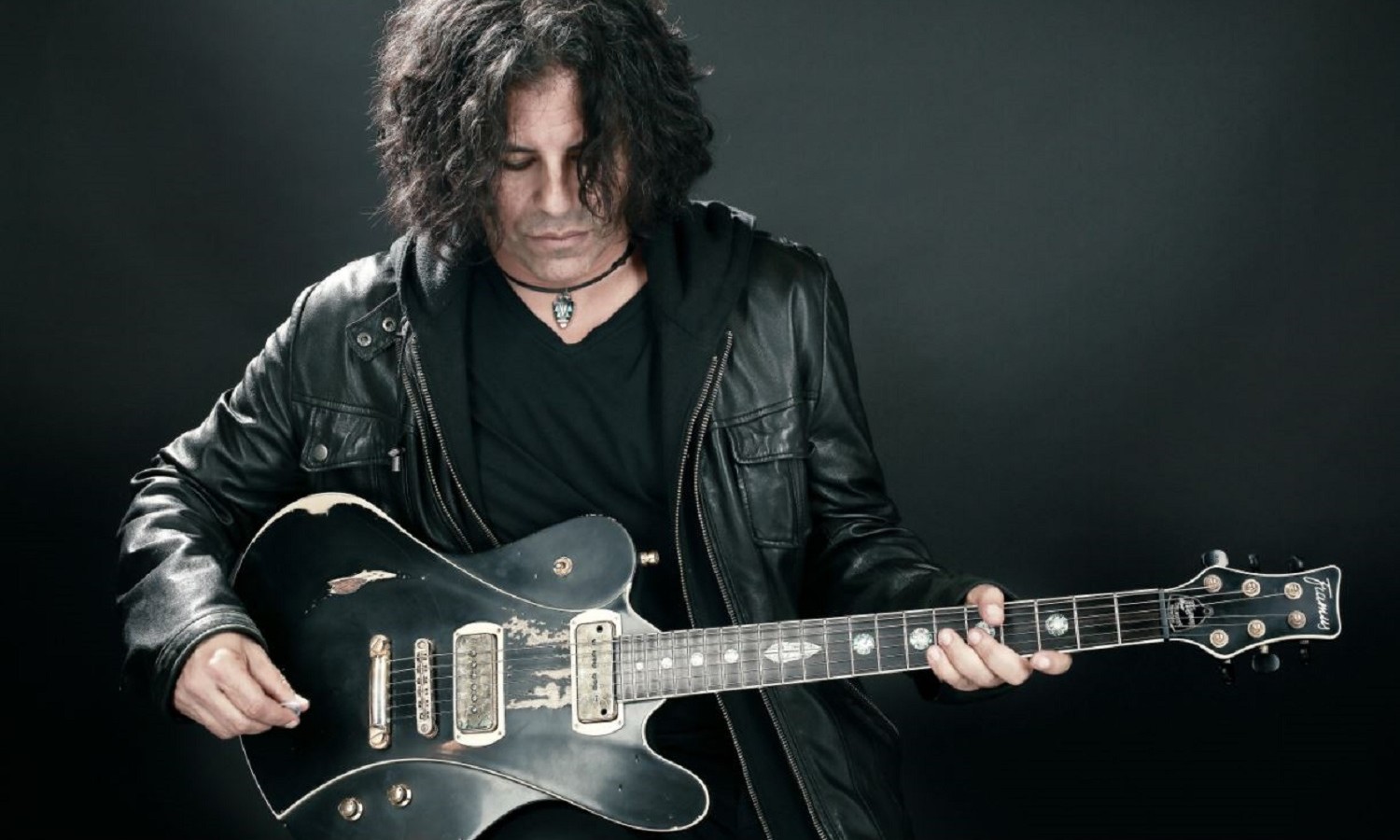Born in Oceanside, California in 1964, Stevie Salas has had the kind of life many people can only dream of. He has been the guitar-slinging music director for rock legends Rod Stewart and Mick Jagger, and the music director and consultant for American Idol, helping unleash the talents of stars like Kris Allen, Chris Daughtry and Adam Lambert. He has also recorded with artists like Justin Timberlake, T.I., Buddy Miles and George Clinton.
On top of that, Stevie continues to enjoy an incredibly successful solo career, with several studio and live albums to his credit, making huge breakthroughs to superstardom in Japan and Europe. He has also scored several films including Bill & Ted’s Excellent Adventure, and he recently produced the internationally-acclaimed film Rumble, which explores the contributions that Native Americans such as Link Wray, Charley Patton, Robbie Robertson and Jimi Hendrix have made to rock and roll history. The film won a Special Jury Award at the 2017 Sundance Film Festival, and was in-part inspired by a Smithsonian exhibit that Stevie helped create entitled Up Where We Belong: Native Musicians in Popular Culture.
A decade ago, Stevie met Kenny Hill, a Mohawk Indian from the Six Nations Reservation in Ontario, Canada. Kenny sought Stevie’s help to build a recording studio for indigenous people. Together, they made it happen, and created something that rivals anything found in London, New York or Los Angeles. Kenny also introduced Stevie to the Dreamcatcher Charitable Foundation: a unique charity founded by indigenous people, and serving indigenous people. Stevie was immediately interested in helping, and tapped into his amazing array of contacts to line up some of the biggest rock stars in the world for Dreamcatcher fundraising events such as ZZ Top, Guns ‘n Roses, and Brian Wilson of the Beach Boys.
Tell us a little about the Dreamcatcher Charitable Foundation
“Dreamcatcher is all about helping indigenous people in a variety of meaningful and special ways, like helping a family take a dream trip to Disneyland, or helping young people pursue training in athletics or modeling. We also improve infrastructure and communities. For example, we have spent millions on parks and playgrounds located on reservations, and helped install clean water and filtration systems.
“As you can see, we stay very true to the name Dreamcatcher. We do small things and big things that make a real and meaningful difference, and help make the impossible, possible. And there is no age limit, either. If we see a chance to help an indigenous person, we try to make it happen. To date, Dreamcatcher has spent over 25 million dollars to help indigenous people. It should also be mentioned that nobody gets paid to sit on the board for the charity. It is entirely volunteer-based.”
How did the Dreamcatcher Charitable Foundation emerge in your life?
“When I was young, all I wanted to do was be a rock star. I surfed and I lived on the beach in San Diego, and then I went to Los Angeles where in 1988 I was lucky enough to be playing stadiums with Rod Stewart. But sometime during the 1990s, I started becoming a person that I didn’t really like. And so, I decided that I needed to go back to Indian country, where I could ground myself and regain balance.
“Then around 2000, I was in Canada opening for the Rolling Stones, and I realized that while I loved what I did and was grateful for my success and life, I needed to do more. I didn’t just want to be known as a famous guitar player who jumped around on stage like a monkey. Powerful indigenous people used to ask me: “how are you on Jay Leno and Letterman, but no other Indians are?” I told them it has nothing to do with being an Indian. It has to do with the art and the hard work. And so, I started helping young indigenous people learn about how to get things done in the music business. It really helped that they could relate to me.
“That experience led me to meet Kenny Hill at Six Nations, which in turn led me to being part of Dreamcatcher. Since that time, I have enjoyed so many special, rewarding and unforgettable experiences.”

In what ways do you support the Dreamcatcher Charitable Foundation?
“I regularly donate to Dreamcatcher, and will continue doing this for as long as I live. I also help raise funds and spread awareness of this incredible organization, and the life-changing work that it is doing for indigenous individuals, families and communities. The work is incredibly satisfying, inspiring and rewarding.”
Can you tell our readers a little bit about Dreamcatcher’s Funding Areas?
“Dreamcatcher provides funding to eligible applicants in education, the arts, sports, and healthcare to aboriginal youth and community members in our traditional Iroquois territories of Ontario and New York.”
What makes Dreamcatcher unique?
“We are one of the few indigenous charities located on an indigenous reservation, with funding that is primarily donated from on-reserve business, that exclusively serves and supports indigenous people, who are located on many different reservations.”
How has Dreamcatcher impacted the lives of the families?
“Sometimes, just a little bit of help is all it takes to get people over the hump, and enables them to make their dreams come true. Frankly, there is a lot of hopelessness out there. Just letting someone know that they aren’t alone, and that people care for them, can have a profound impact on their life. And hopefully, they will also pay it forward.
“The reservation is a different environment than the one that I grew up in. I was lucky. I had a very strong father figure in my life. On the reservation, a lot of kids don’t have that, and so we try to help parents enhance their skills. And I can tell you that things are getting much better, and the improvement in the last 10 years has been incredible. We are definitely headed in the right direction.”
How has community support changed over the years?
“Support for Dreamcatcher keeps growing, because we are making such a significant and sustainable difference. When I reach out to my rock star friends in Hollywood and New York and Nashville, and tell them about the amazing work that we’re doing, they all want to be a part of it. It’s done out of love and a desire to help and learn.
“It is also wonderful that the biggest Native American celebrities come to our events, regardless of how small those events might be. For example, Tia Carerre is a long-time supporter, and so are Gil Birmingham who is huge on the show Yellowstone, Academy Award-winning actor Wes Studi, Graham Greene, and Tantoo Cardinal. Each of these amazingly talented and very influential people send the message that we’re all in this together. It’s very inspiring, and the impact is tremendous.”
Can you share with us some of the success stories?
“There are so many that it’s hard to pick just one. However, one experience that is really etched in my memory is about a young woman who was around 18 or 19 years old who had a dream of becoming a singer and a recording artist. She was working really hard at it, and giving it everything she had. But then she became pregnant. Fast-forward more than a decade, and she is 32 with two kids. She had never forgotten her dream of becoming a singer and a recording artist, but never imagined it would be possible. Well, guess what? Dreamcatcher helped her make a record, and the next thing you know she won an award at the Indigenous Music Awards! She said that it was the greatest moment of her life.”
Can you tell us how someone looking to support Dreamcatcher Charitable Foundation can help?
“The best way that people can help is by making donations, because the funds can then be used in the most effective and efficient way possible. Anyone who donates can rest assured that all of their money will be put to the best use possible. Donations can be easily and securely made on the Dreamcatcher website (www.dcfund.ca).”
What is one piece of advice you would like to leave our readers with?
“I would say never give up on your dream. Just like that young woman who thought she would never become a singer and recording artist, you never know when your dream might come true. Keep dreaming, keep striving, and keep hoping. Trust me, amazing things can happen!”


